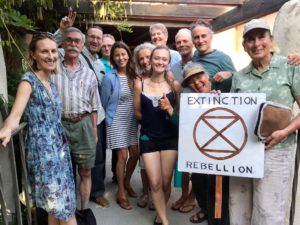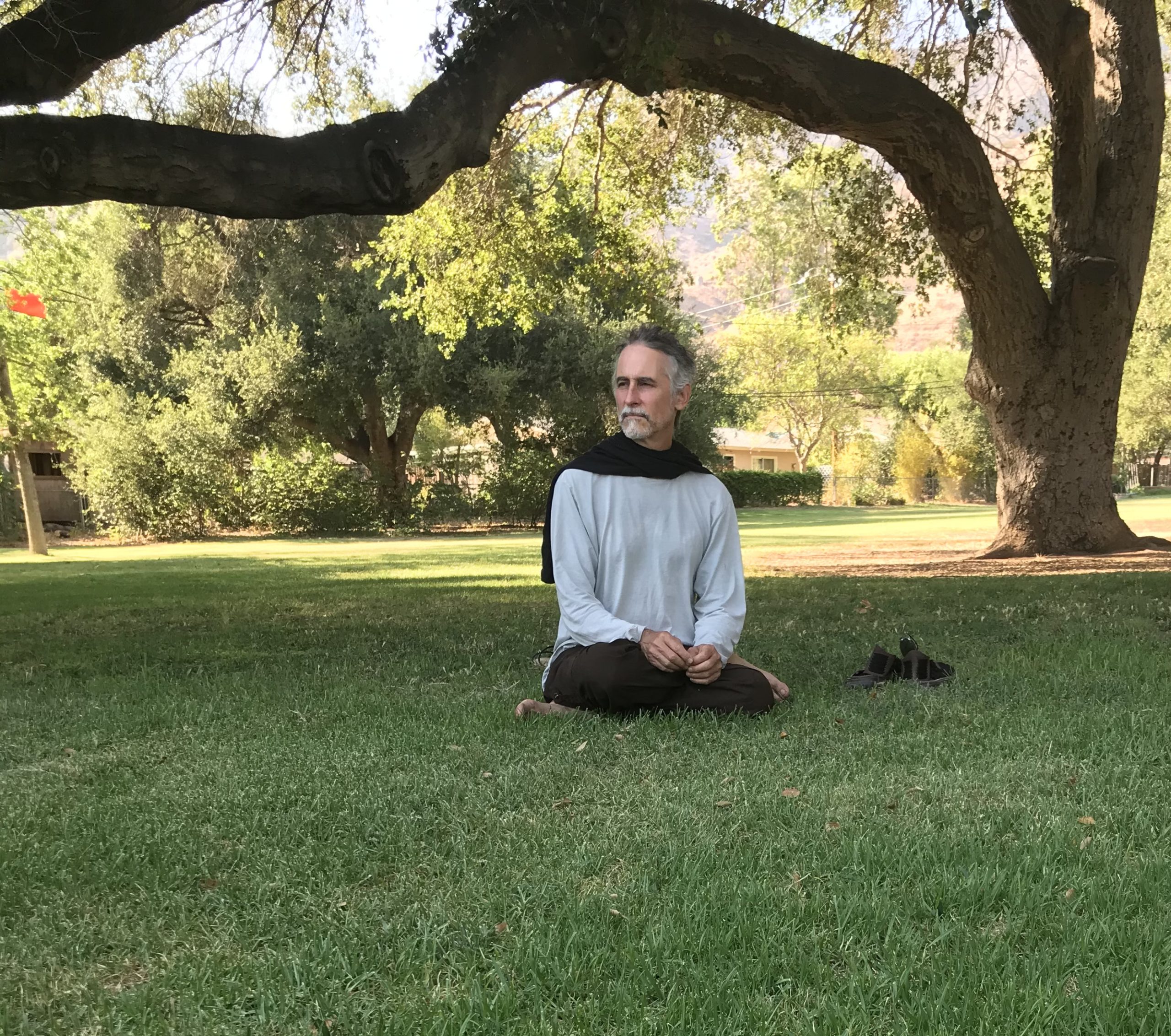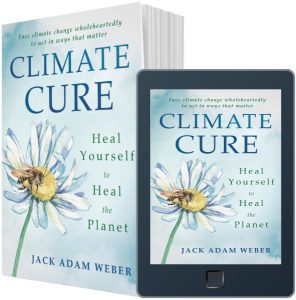Originally Published at: https://www.theresilientactivist.org/healing-myself-to-heal-the-planet/
When I was 26 I embarked on the most profound healing journey of my life. I worked with a therapist from a body-centered, somatic place to unearth my core childhood and relationship love wounds. I thought I was going into therapy to work on my dad issues, but what I discovered in my body, and unknown to me when I began, was how big my mother (Earth) wound was. Even further beyond my comprehension was how that inner work would prepare me to be an activist.
What Climate Activism Demands
Without the emotional intelligence gained through that inner work, I would not be the person I am today, not even close. I bring the deep heart I reclaimed to all that I write, to all my relations, and all that I love and fight to protect. Personal emotional work prepared me for climate activism because what you need to be an activist is not only the courage and capacity to endure painful realizations and experiences but to know how to transform them into passion and purpose. Without this alchemical heart, one easily shies away or becomes overwhelmed. This is why I devote so much attention to emotional healing in my new book Climate Cure: Heal Yourself to Heal the Planet.
It’s crucial to have a transformation-ready heart when embarking upon activism. Otherwise, we can be setting ourselves up for pain that sticks to our bones, because confronting injustice requires resilience and the ability to transform pain into passion and purpose. Indeed, many who resist voicing themselves and getting involved in causes greater than themselves may instinctively know they do not possess the inner alchemical capacity to transform pain, or feel too burdened by it already, and thus resist getting involved. Worse, they may deny that the problem exists in the first place so they don’t have to feel the consequences of reckoning with it.
This is precisely why learning and practicing how to embody and be renewed by difficulty is crucial for creating a new world. In other words, our fear of pain, and not being supported in it or knowing how to be renewed by it, limits our capacity to heal both ourselves and the planet.

Before Therapy
In the years previous to therapy, during my early twenties, I remember going to satsangs (spiritual wisdom gatherings) to listen to Indian and Western gurus (teachers) speak. My friends would dread going with me because I would relentlessly ask them all the same question: What do I do with my pain? They usually gave a pat response. So I would drill down with further inquiry, as far as they would go with me. None ever went far enough or answered to my satisfaction.
After exhausting myself with gurus, and on the constant recommendation of a mentor, I went to see a therapist he recommended. I didn’t really know what I was getting into, though I was still seeking an answer for what to do with my pain. I was simply encouraged to go (after resisting over and over) and finally made the call . . . to my future therapist, Charlene.
I arrived to psychotherapy with a robust body-mind background in yoga, tai chi, meditation, and nature connection. Despite all this “spiritual” practice, I still felt angry and largely unfulfilled. As I later realized, this is because the unreckoned pain I held inside created the feeling of a void. All the “spiritual” practice I engaged in hadn’t really touched aspects of me that were holding me back from a fuller life. Yet, the practices did provide me with the necessary body-mind integration I needed for somatic psychotherapy—to dip deeply into my body and sensitively decipher its messages and story of loss—so I could take the next step . . . into . . . who knew what! Each inner discovery was like a stepping stone that led me to a new pool of discovery. Eventually, all the separate pools joined in my belly for the heart of inner child work.
Embodying Heartache
On my first day of therapy, and of my own accord, I sat down on Charlene’s couch and intuitively dropped my awareness down into my body—as if I were meditating, as I had done for years. But this time I did it differently. Instead of merely being mindful of my breath and body, I listened into the pain and began to give the physical pain a voice. This became my narrative of wounding that guided me through a deep dark night of my soul, and eventually into being a much fuller and richer human being. The process was so profound and transformative that I view my life as “before and after” it.
From that day on, I stopped avoiding my heartaches. I embodied the expression, “You have to feel it to heal it.”
I persisted for some two and a half years in that office with Charlene, who held incredible, compassionate space for my process to unwind, sometimes two and rarely three times a week when it was especially gnarly. I discovered that grief and love are two sides of the same coin. What I engaged I later came to call “grief work,” for which I am almost done completing an audio guide for how to enter that deep work. I cried more during that time than in my whole life, a lot more. I visited all the empty, numb, blocked, tight places in my body and felt through their pain of abandonment and fracture. Speaking, writing, and emoting their story of loss helped me feel—and heal—the ache even more.
The journey was utterly paradoxical. The more I embraced and welcomed my fears and grief, the more fully they moved through me, until finally one day, my inner waters ran clear. Surprisingly, my emotions changed me in the process. I discovered that I didn’t let go of pain; it let go of me once it was done transforming me. The trick was therefore to welcome, embody, and surrender to the process. When we suffer a physical wound or infection, we fix and attack it to make it go away. Emotional healing is different: we welcome the pain so it can renew and eventually release us.
That work cleared space in me to feel more of my own and the world’s struggles. During one stint, while processing my grief over a relationship breakup, I remember my astonishment at how deeply I felt the pain of that loss. My therapist commented: “There is so much more of you now available to feel it.” Indeed, I had freed up enough of my heart from past trauma to be able to more deeply and fully grieve the current loss—there was now the room inside to accommodate it. The same seems to hold true for collective, climate grief. When we are backlogged with pain, we can’t take much more; we just don’t have room for it. So we ignore the climate crisis, with the result that the crisis slogs on, without enough of our passionate care and action to heal it.
Our Personal Lives and Climate Change
I uncovered all the pain I could find in my body and loved it into vitality. This is why I write so much about paradox, fertile darkness, somatic work, embracing our humanness, emotional intelligence, and especially, grief work. All of these dynamics apply just as much to climate as to our personal lives. As I mention in Climate Cure: the same emotions we need to heal our personal struggles are precisely the same as those we need to minister to the planet. Perhaps this is why Nobel Prize-winning psychologist Daniel Kahneman says of the climate crisis, “To mobilize people, this has to become an emotional issue.”
During that dark night of the soul work in therapy, I poignantly realized that I was in the workshop of workshops. Previously, I had attended lots of self-help classes, but nothing touched and landed like my grief work in therapy. I realized I found what I had been looking for to deal with my pain. My interest in self-help workshops dropped away when I began this work. I also let go of much of my spiritual practice because it largely just got in the way and wasn’t needed anymore. I needed to be with my pain, fully, not rise above, get around, physically unwind, un-believe, or otherwise try to ameliorate it with other practices. I needed to get to know it, listen to it, converse and commune with it, and most importantly, feel it.
Since that time, life has dealt me more pain and loss, of course. But it has been different, easier to deal with, and I think less intense. That’s because I had already drained the swamp, so to speak (and yes I am reclaiming this expression for good!), of the underlying fuel —my backlogged pain.
Dedication to Activism
My dedication to activism, to making the world a better (and more habitable) place, grew out of dealing and reckoning with my own pain. The more I got in touch with my own neglect and wounding, the more I appreciated we neglect the planet (and one another). When abandonment wounds and unreckoned grief run amok, we abandon others, including the Earth. Learning first-hand how to embrace and work through my own pain broke my heart open to everyone and everything’s suffering. The more I cleared my own backlog, the more room I had for the troubles of the world. I was able to care more for both because I was no longer so burdened with pain.
Today, I am perpetually frustrated and saddened by the lack of will to address the climate crisis and other collective traumas. In truth, people’s traumas and stresses may just not afford them the bandwidth, especially perhaps the poor and underserved in this country. In other countries, though, people with little means seem to galvanize intensely against injustice amid racism and classism.

Embracing what Hurts
Two of the most important capacities for the death and rebirth work I engaged in were humility and self-honesty. It takes a lot of humble surrender to admit our shortcomings and rest in our pain. Shadow, dark night of the soul, work requires blistering, brutal honesty—what goes unacknowledged goes unhealed, with the result that change doesn’t happen. Self-honesty, humility, and courage were the fuel for being transformed by my pain.
Much of what’s true hurts. And if we aren’t comfy with hurt, we aren’t gonna be comfy with a whole lotta truth. Denial leads to demise. I imagine this is why New Age spiritual beliefs persist: they provide shelter from difficult truths, from pain. And it’s why I try to help people out of that silo of denial. I have compassion for those who pursue magical beliefs because the pain that often underlies a flight from the everyday is real and needs care, not blame or confrontation. Healing happens only when someone is able to realize their unhelpful patterns, and this happens on no one’s time but their own. Learning what is possible, beyond bypassing pain, can plant a seed for when they are ready.
That work in my 20’s was foundational inner work, addressing the core love wounds of my past, which I have since only had to revisit in stints and milder fashion. I don’t listen to “spiritual” gurus speak anymore. My guru was inside me the whole time: my pain. It awakened me. I have also come to realize that most people have no clue that this process is possible, that by facing and embracing our greatest pain in an embodied way, the greatest goodness can emerge.
The pain we don’t address, we inflict on others, overtly or by neglect. Hurt people hurt others.
Collective Pain Causes Violence
On a global level, our collective unreckoned pain causes tremendous violence. Systems, institutions, and individuals dole out their hurt in a perpetual cyclone of dishonesty, mindless compulsion, numbed heart and body, and greed. When we don’t healthily vent our pain, we dish it to others by acting it out—misery likes company and creates more of it, until reckoned. I see this every day and it infuriates and, thankfully, saddens me. The more healed people we can nurture, the more power we have to change the paradigm and save our present and our future. This work begins with ourselves. It’s an inside job and progresses with the support of others.
For all these reasons, mental health services must not only be improved and trauma-informed, but made more available to others who suffer, often alone, impoverished, and in horrific silence.
In addition to fighting for outward change, we must therefore show up with compassion for all pain running amok. That’s hard to do in the face of lies, injustice, stubborn ignorance, and violence, not to mention the stress and pain with which each of us is daily already saddled. Indeed, when I am dealing with personal strife, I have less energy and bandwidth for the problems of the world. This is telling and shines a light on an important dynamic contained in this essay I wish to repeat: when we have an existing load or surfeit of unconscious or conscious pain, we have less room available for the amount of pain we can handle in our day-to-day before we become saturated. The more trauma and wounding we heal—together—the more we can mobilize for the climate crisis.
Importantly, a good deal of what people think they can’t handle is an unconscious, knee-jerk reaction to fear. Taking deep breaths, conjuring willingness, welcoming support, we can handle more than we initially, fearfully, jerk away from . . . and even find belonging, purpose, and power in the challenge.
A Trifecta of Resilience
The resilient support network for our times I view as a trifecta, which I call our “Triangle of Resilience Relationships.” This triangle consists of 1) a healing relationship with ourselves, 2) intimacy with the natural world, and 3) intimate connection with human community. I quote from Climate Cure:
“These three drivers—with self, nature, and one another—represent our ‘triangle of resilience’ relationships. Our neglect of these relationships is a radical cause for the symptom of climate crisis. Forsaking any of these relationships causes damage. In the same way a robust union of these relationships confers exponential strength, abdicating two or more invites catastrophe . . .
In contrast, revitalizing our essential relationships builds a triangle of resilience. These relationships dictate the unfolding of three major climate change dynamics. When marginalized, our debilitated triangle of resilience relations are the underlying drivers for climate change’s inception and perpetuation. When nourished, they are the best means we have to cope with and thrive through climate chaos. And when they are robust and stable, these relationships are the best way to radically mitigate climate damage.”
When we clear our backlogged pain, we can handle more everyday pain, as I recounted earlier: I was able to feel the pain of loss more deeply over losing my partner once I had begun to clear out my depths. This also prevented the grief of my relationship from congealing into protracted suffering.
Dealing with our backlogged pain also frees up more bandwidth to be honest and to participate in the healing of the world, which is the love of activism—to care about and act for others through the light and dark of a wounded healer. This is how I see us healing ourselves to heal the planet.
Here’s a presentation on “Caring Enough” I made at our local Extinction Rebellion meeting.
Realistically, many seem to have little or no interest in being emotionally and intellectually honest or doing any serious work with themselves, sadly enough. So, let us be the heroes and show up for those who can and will, beginning with ourselves. If nothing else, we will need the resiliency, the alchemical heart, we forge from doing so to endure tougher times ahead—to become more able to face, metabolize, and engage the pain of crisis amid the world’s shattered heart . . . and to heal what we can.
Thank you for caring enough to read this far and considering your own healing for the greater good. I conclude with a line from my poem “Thanksgiving”:
Didn’t you know the heart
Was meant to break a thousand times
To make everything beautiful again?
With love and hope for our world, Jack


